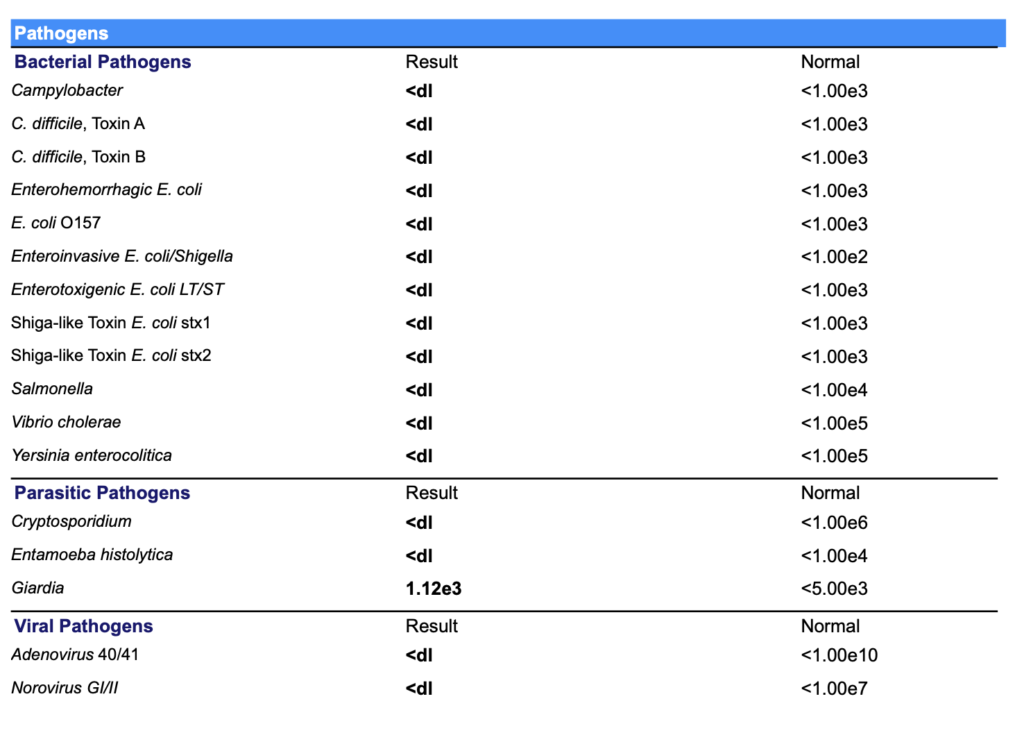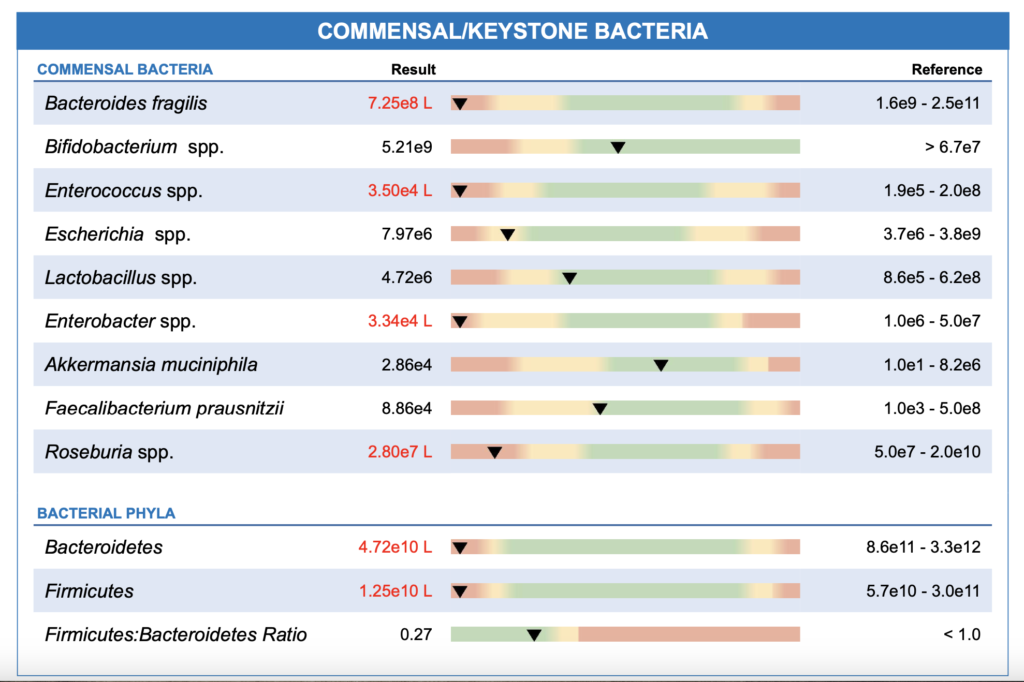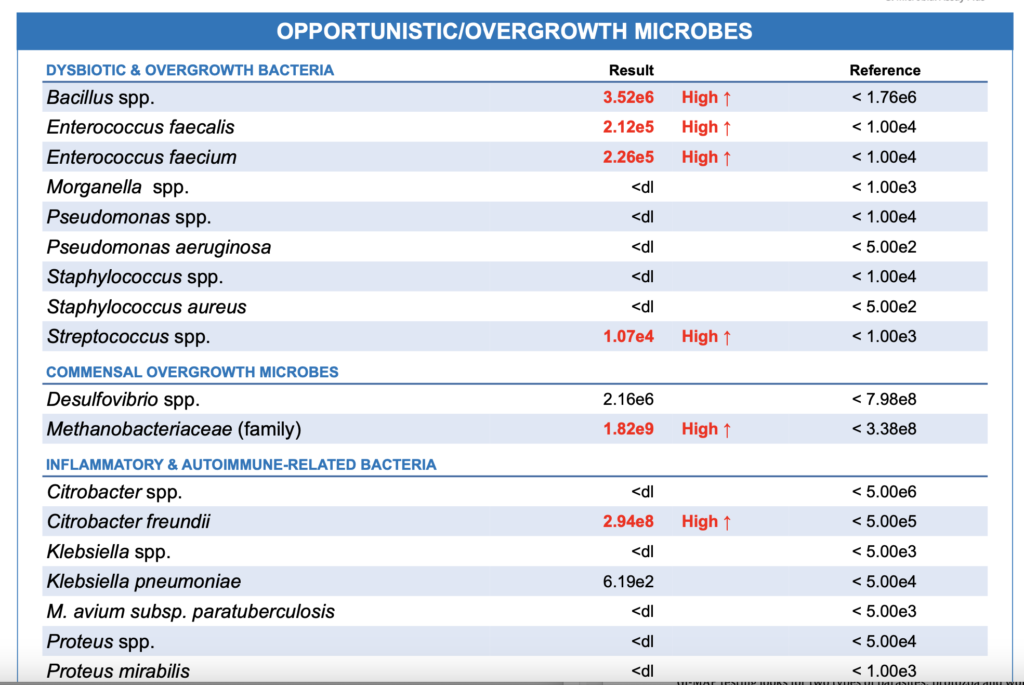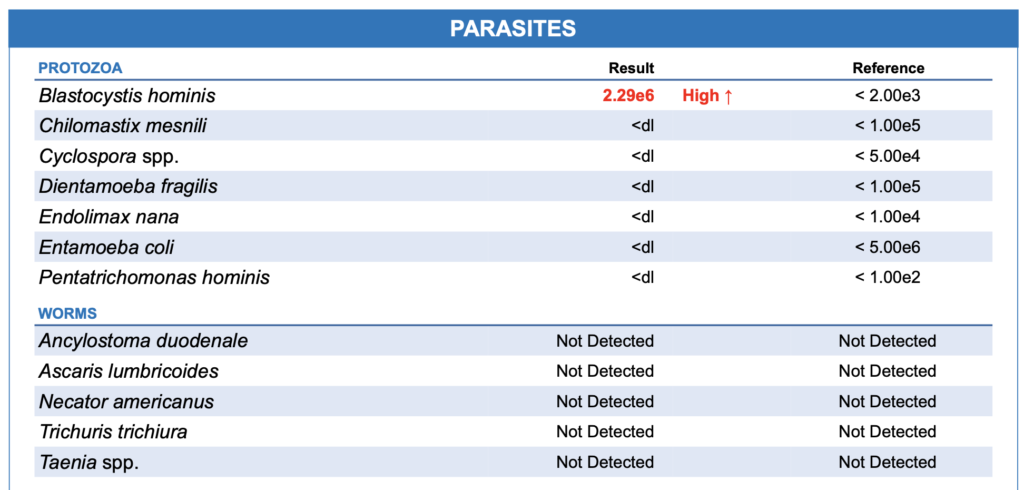
The GI-MAP gut health test is a super simple at-home functional stool test that allows us to see not only which microbes (gut bugs) are present in your GI tract, but also how well your organs and entire gastrointestinal system is working.
This is the stool test that I use with every single client to diagnose the root cause of all of the gut-related symptoms that you’re having. It’s just one simple poop test, and then we’ll know exactly what is going on with your gut and why you’re experiencing symptoms.
Once we have your test results, we’ll have a private 1:1 90-minute session to go over your test results so you will be crystal clear about exactly what is at the root of all your symptoms. No guessing!
What Does the GI-MAP Test For?
The GI-MAP uses a unique technology for testing, it’s quantitative-PCR technology, not PCR like the rest of the stool tests. That means you get an actual number… how many of each bacteria, parasite, virus, etc. are present in your stool sample. This is incredibly informative and is what I use to design my customized protocols that use natural methods for rebalancing the gut microbiome. These protocols include:
- Nutrition and food options
- Lifestyle and habits
- Herbal supplements and probiotics, if necessary
Let’s check out a GI-MAP sample report and see what sort of information you’ll get.
Pathogens
The first page of the GI-MAP diagnostic stool test measures for various pathogens: bacterial, parasitic, and viral. These are pathogens that would generally make someone very sick if they were infected. Some of these are pathogens you’ve heard of, like Salmonella, E. coli, and C. difficile, but others are relatively unknown like Campylobacter and Giardia.
Generally, if you’re infected with one of these bugs, you would usually be headed to the hospital or your doctor for the typical treatment, antibiotics. When possible, herbal treatments are recommended in order to limit damage to your protective beneficial bacteria.
While most people typically do not have these pathogens present, do know that you can be asymptomatic carriers of certain bacteria like C. difficile. Sometimes the presence of these bacteria indicate a past infection that needs a little assistance to move out of the GI tract completely. Other times, symptoms are present and the active infection needs treatment.
In the example below, this client had an acute Giardia (parasitic) infection, with symptoms including urgent diarrhea, cramps, and inability to properly digest and absorb food. She had nutrient deficiencies and had started to lose handfuls of hair at the time of this test. Her GI-MAP showed the presence of this parasite as well as significant inflammation. We treated her with herbals specifically targeted to eliminate this parasite successfully. She felt better within 30 days. Continued anti-inflammatories allowed her to completely return to her normal gut function within a few months.

Helicobacter pylori
H. pylori is a sneaky little bacteria that colonizes the stomach in about 50% of the world’s population, and I actually see it on the GI-MAP result of many of my clients. H. pylori has a corkscrew-shaped “tail,” which it uses to screw itself into the cells of your stomach lining, allowing it to hide and evade detection. So, as you can imagine, most other tests for H. pylori (including biopsies taken during a colonoscopy!) simply aren’t able to detect it, and so people get a false negative test and H. pylori is mistakenly ruled out.
H. pylori has been known to contribute to conditions like acid reflux/GERD, gastritis, stomach cancer, and even thyroid disease. H. pylori thrives in a less acidic stomach environment, and one of the ways in which it creates this optimal environment (optimal for itself, not for you) is to neutralize stomach acid. Often, this creates acid reflux, which is actually a condition of low stomach acid, not too much like previously thought.
An acidic stomach environment is required to prevent colonization of pathogens and this can cause imbalances in our microbiome further down the digestive tract as well as lead to inadequate digestion, especially of protein, and malabsorption of vitamins and minerals.
This client had a history of weight gain, constipation, bloating, gas, burping, anxiety, low energy, and sugar cravings. She had taken an H. pylori test with her doctor, but that test result was negative. You see here, the GI-MAP accurately diagnosed her H. pylori infection so that we could treat it.
Commensal/Keystone Bacteria
The GI-MAP tests for a variety of beneficial, aka keystone, bacterial so that we can see the exact status of this group of bacteria that act as protectors in our digestive system. The commensals are the “good” gut bugs that have quite a lot of health benefits. They play important roles in our metabolism, the health of our intestinal lining, immunity, production of SCFA (short-chain fatty acids) and they produce neuromodulators like dopamine, serotonin, histamine, norepinephrine, which greatly impact our mood.
These beneficial bacteria as a group provide some protection against harmful bugs, so we want a strong, robust group of these guys. When there aren’t enough beneficial bacteria, you can experience gas, bloating, inflammation, and even intestinal permeability, or leaky gut.
When we see imbalances in these commensal beneficial flora on the GI-MAP, either as a deficiency in these “good” bugs or an overgrowth of them, we can target our recommendations to better rebalance your gut microbiome. You want a strong group of these badasses so they can continue to support you and your overall health.
This client was eating a really clean diet, but she had been dealing with COVID long-term. COVID, regardless of duration, depletes the beneficial bacteria to the point that harmful pathogens are allowed to grow. As you can see, her beneficial bacteria were low or trending down and she needed some serious support to regrow these important species. She is now fully recovered and her latest GI-MAP showed a healthy level of commensal bacteria.

Opportunistic/Overgrowth Microbes
The bacteria in this section are those that cause illness and disease only when they’re overgrown. They take the opportunity to cause inflammation and gastroenteritis in some people, often those that are vulnerable, but can be beneficial when they’re at normal levels.
Overgrowth and excessive colonization by opportunistic bacteria may occur when the commensal/keystone bacteria are impaired by poor diet, antibiotic use, parasitic infection, or a weakened immune system. When leaky gut is present, these microbes could escape the lumen of the gut and infect extraintestinal sites, typically causing autoimmune issues. Overgrowths of these bugs, especially specific inflammatory species, can contribute to many digestive symptoms, including diarrhea, loose stools, abdominal pain, or even constipation.
Several of the bacteria in this section overgrow due to low stomach acid if H. pylori is also present, and thus, will normalize once that pathogen is eliminated. Other bugs, though, can trigger inflammation and autoimmune diseases unless eradicated. Using the GI-MAP, we can see which specific species are overgrown in the microbiome, and are then able to better target them specifically to rebalance the gut microbiome as a whole.
This client ate the standard American diet and also had H. pylori present. She struggled with gas, bloating, constipation, anxiety, and had about 20 different food intolerances. We also see from her test result that she had low stomach acid caused by H. pylori and was overgrown in several bacteria that produce histamine. After several months of treatment for H. pylori and this overgrowth, she continues to heal and rebuild her beneficial bacteria, and her symptoms have all but disappeared.

Fungi/Yeast
Fungal organisms are super common in the digestive tract, but overgrowth of these organisms can cause symptoms and illness in some people. Common causes of yeast or fungi overgrowth include: antibiotic use, food intolerances, low stomach acid, imbalanced gut bacteria overall (dysbiosis), or a high intake of sugars, starches, and fungi-containing foods/drinks like beer, cheese, bread, nuts, and corn.
Interestingly, fungi or yeast overgrowth can not only show up as gastrointestinal symptoms like gas, bloating, constipation, nausea, vomiting, and diarrhea, but also as skin symptoms such as eczema, athlete’s foot, thrush, vaginal yeast infections, and jock itch.
This client suffered with reflux, bloating, occasional diarrhea and weight gain. She also had elevated levels of H. pylori, parasites, 5 overgrown beneficial bacteria and 7 overgrown opportunistic bacteria… and this Candida as well. Her treatment took several months to clear all that overgrowth, but she is now feeling back to her healthy self.

Parasites and Worms
The GI-MAP tests for two types of parasites: protozoa (some of which are non-pathogenic) and worms most commonly occurring in the GI tract. Protozoa are similar to bacteria but are more highly evolved, while worms are just the slimy things that make you a little queasy to think about them in your gut. Typical mode of transmission is fecal contamination of food or water.
Parasites are organisms that live and feed off the host at the expense of the host (YOU!). The GI-MAPThey can contribute to altered bowel movements, fatigue, skin concerns, nausea, weight loss, and more.
Whenever we see parasites on a GI-MAP, this is something we definitely want to eliminate because they can be highly inflammatory and the symptoms are often sudden and urgent. These symptoms can include: diarrhea, abdominal pain, vomiting, fever, fatigue, IBS, arthritis.
This client had life-long constipation, life-long use of antibiotics, depression, bloating, gas, belching, several food intolerances. Her GI-MAP also showed H pylori, lots of overgrowth, but her beneficial bacteria was nice and strong due to her daily habit of eating fermented foods. She has found some relief from her symptoms, but is at the beginning of her protocol and has several more months of treatment before she is back to normal.

Intestinal Health Markers
Probably the most informative panel on the GI-MAP is the Intestinal Health Marker panel. Here, we get a comprehensive look at overall digestion – whether the solid organs of the digestive tract, the pancreas, the gallbladder, and the liver are doing their jobs effectively and producing ample digestive enzymes and bile.
We also get a glimpse into the level of inflammation in the gut, whether gluten is producing an immune response, and how well the gut detox pathway is working to clear harmful substances from the body. We also have access to the add-on test, Zonulin, which tells us to what degree leaky gut is present.
This client was experiencing bloating, gas, food intolerances, constipation, and anxiety for several years. We see here that this client is not producing enough digestive enzymes or bile and needs some detox support as well. While there is no gluten sensitivity present on this test, the client does have some inflammation and is trending towards leaky gut.

How Does It Work?
The process is simple, the test kit arrives at your house, you provide a sample (they include detailed instructions on how to do this) and then you send it back to the lab. In 10 – 12 business days, your report will be ready and from there, I’ll figure it all out for you. In a couple of weeks, you could know exactly what’s causing your symptoms… pretty amazing, right?
And Then What?
If you have organisms like parasites or harmful bacteria to eliminate, then we will target these harmful organisms that are highlighted on your GI-MAP. I’ll customize a nutrition, lifestyle, and supplement protocol that will address these specific organisms. This is the stage at which you are going to start feeling like your old self, with a significant reduction in symptoms.
If you don’t have any organisms overgrown, then we’ll focus on setting you up for future gut health success. By rebuilding a strong robust gut microbiome that is able to easily manage any toxins or pathogens that come, we’ll prevent you ever returning to this place you started ever again. An individualized nutrition, lifestyle, and supplement protocol will be tailored to your needs according to the results of your GI-MAP.
Gut Health Diagnosis at EverVital Nutrition
Are you struggling with symptoms of gut inflammation like diarrhea, cramping, or bloating? Gut inflammation is a common health concern that can be short-lived or chronic, depending on the underlying cause. Many people suffer from chronic gut inflammation due to poor dietary habits and bacterial overgrowth.
At EverVital Nutrition, we use specific diagnostic tools to determine your level of gastrointestinal overgrowth, digestive function, and inflammation. It’s a comprehensive gut microbiome test, rather than a guess.
To learn more about gut inflammation and get on the path to healing, contact us today.











